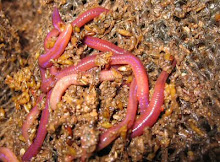
An update on how the second harvest is being used:
E., my friend and Hogwarts Garden overseer, used her vermicast to fertilize a bed of winter squash; said squash will be used in soup a few weeks from now. Can't wait to see the happy results. And L. will be using hers to feed her roses. M. and I have spread our bounty throughout our backyard garden: the pakalana plants, in particular, seem to be thriving, and our banana trees are issuing fruit. A few tomato plants have also unexpectedly sprung from the vermicast; suspect they're the scions of some overripe grape tomatoes one of my freshmen had fed to the worms over a year ago. Amazing to think that the seeds still remain viable after so long and after worm processing. But in our case, the renegade tomatoes are a welcome addition, making for a merrier garden, so we've let them be, in the hope of reaping future rewards.


